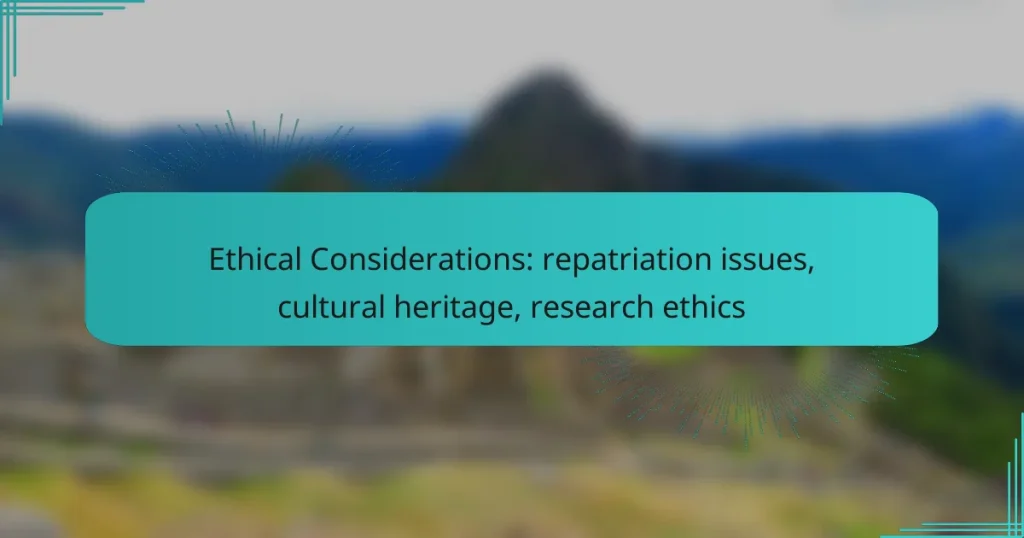Ethical considerations surrounding repatriation issues, cultural heritage, and research ethics are critical in fostering respect and collaboration between institutions and Indigenous communities. Recognizing Indigenous rights and adhering to legal frameworks are essential for the responsible return of cultural artifacts, while research ethics emphasize the importance of informed consent and transparency. These principles guide the preservation and respectful handling of cultural heritage, ensuring that the voices of originating communities are prioritized in the process.

What are the ethical solutions for repatriation issues in Canada?
Ethical solutions for repatriation issues in Canada involve recognizing Indigenous rights, fostering collaboration, and adhering to legal and international standards. These approaches aim to restore cultural heritage items to their rightful communities while ensuring respectful and equitable processes.
Collaborative agreements with Indigenous communities
Collaborative agreements with Indigenous communities are essential for effective repatriation. These agreements should involve open dialogue, mutual respect, and shared decision-making to ensure that the interests and perspectives of Indigenous peoples are prioritized.
Engaging in co-management practices can facilitate the return of cultural artifacts, allowing Indigenous communities to lead the conversation on how their heritage should be preserved and displayed. This approach fosters trust and strengthens relationships between institutions and Indigenous groups.
Legal frameworks for repatriation
Legal frameworks for repatriation in Canada include various laws and policies that guide the return of cultural heritage items. The Indian Act and specific provincial regulations outline the rights of Indigenous peoples regarding their cultural property.
Institutions must navigate these legal structures carefully, ensuring compliance while respecting the wishes of Indigenous communities. It is crucial to stay informed about any changes in legislation that may impact repatriation efforts.
International guidelines on cultural heritage
International guidelines on cultural heritage, such as the UNESCO Convention on the Means of Prohibiting and Preventing the Illicit Import, Export and Transfer of Ownership of Cultural Property, provide a framework for repatriation. These guidelines emphasize the importance of returning cultural artifacts to their countries of origin and respecting the rights of Indigenous peoples.
Adhering to these international standards can enhance the credibility of repatriation efforts and promote ethical practices among Canadian institutions. Organizations should actively seek to align their policies with these guidelines to ensure responsible stewardship of cultural heritage.

How do cultural heritage laws impact repatriation?
Cultural heritage laws significantly influence repatriation by establishing legal frameworks that govern the return of cultural artifacts to their countries of origin. These laws aim to protect cultural property and ensure that it is preserved and respected, impacting how institutions and governments navigate repatriation requests.
Canadian Cultural Property Export and Import Act
The Canadian Cultural Property Export and Import Act regulates the export and import of cultural property, including artifacts of historical significance. This law requires that any cultural items being exported from Canada must be assessed for their cultural value and may require permits to ensure they are not lost to the national heritage.
Under this act, institutions seeking to repatriate artifacts must demonstrate their cultural significance and may need to provide documentation to support their claims. This process can involve negotiations with Canadian authorities and the original communities or nations from which the artifacts originated.
UNESCO conventions on cultural heritage
UNESCO conventions, such as the 1970 Convention on the Means of Prohibiting and Preventing the Illicit Import, Export and Transfer of Ownership of Cultural Property, provide international guidelines for the protection and repatriation of cultural heritage. These conventions encourage countries to collaborate in preventing the illegal trade of cultural artifacts and promote the return of items to their rightful owners.
Countries that are signatories to these conventions are expected to implement national laws that align with UNESCO’s principles, which can facilitate repatriation efforts. For example, nations may establish legal frameworks that recognize the claims of indigenous peoples or other communities seeking the return of their cultural heritage.

What are the ethical considerations in research involving cultural artifacts?
Ethical considerations in research involving cultural artifacts focus on respecting the rights and perspectives of the communities from which these artifacts originate. Key issues include obtaining informed consent, ensuring transparency in research methodologies, and addressing the potential impacts on cultural heritage.
Informed consent from Indigenous groups
Obtaining informed consent from Indigenous groups is crucial when conducting research on cultural artifacts. This process involves engaging with the community to ensure they understand the purpose of the research and how their cultural heritage will be represented and used.
Researchers should prioritize building relationships with Indigenous communities and seek their input throughout the research process. This can include discussions about the potential benefits and risks associated with the research, as well as how findings will be shared and disseminated.
Transparency in research methodologies
Transparency in research methodologies is essential for maintaining trust between researchers and the communities involved. Researchers should clearly outline their methods, objectives, and potential impacts on cultural artifacts and the communities they represent.
Providing accessible information about the research process helps communities understand how their cultural heritage is being studied and ensures that ethical standards are upheld. Researchers should also be open to feedback and willing to adapt their approaches based on community concerns and suggestions.

What frameworks guide ethical research practices in cultural heritage?
Ethical research practices in cultural heritage are guided by frameworks that prioritize respect for cultural property, community involvement, and responsible stewardship. These frameworks help researchers navigate complex issues related to repatriation, ownership, and the rights of indigenous and local communities.
Ethical guidelines from the Canadian Museums Association
The Canadian Museums Association (CMA) provides ethical guidelines that emphasize the importance of collaboration with communities and respect for their cultural heritage. These guidelines encourage museums and researchers to engage with local populations in the decision-making process regarding the use and display of cultural artifacts.
Key principles include obtaining informed consent, ensuring transparency in research practices, and acknowledging the contributions of communities to cultural heritage. Researchers are advised to establish long-term relationships with communities to foster trust and mutual benefit.
Principles of the American Anthropological Association
The American Anthropological Association (AAA) outlines principles that focus on the ethical responsibilities of anthropologists in their research. These principles stress the need for researchers to consider the potential impacts of their work on the communities they study, particularly regarding issues of representation and ownership of cultural knowledge.
Researchers are encouraged to engage in ethical reflexivity, which involves critically examining their own biases and the power dynamics at play in their research. The AAA also advocates for the protection of cultural heritage through responsible data management and the respectful treatment of human remains and sacred objects.

How does repatriation affect community identity in Canada?
Repatriation significantly impacts community identity in Canada by restoring cultural artifacts and ancestral remains to Indigenous peoples, thereby reinforcing their heritage and sense of belonging. This process fosters a deeper connection to cultural practices and histories that have been disrupted by colonialism.
Reinforcement of cultural practices
Repatriation allows Indigenous communities to reclaim traditional practices that may have been lost or diminished over time. By returning sacred objects and ceremonial items, communities can revitalize rituals and customs, strengthening their cultural identity.
For example, the return of ceremonial masks or regalia can enable communities to conduct traditional ceremonies that are integral to their cultural expression. This not only enhances community cohesion but also educates younger generations about their heritage.
Restoration of historical narratives
Repatriation plays a crucial role in restoring historical narratives that have often been overlooked or misrepresented. By bringing back artifacts, communities can share their own stories and perspectives, countering dominant historical accounts that may have marginalized their experiences.
This restoration can lead to a more accurate understanding of history, as communities engage in research and storytelling that reflects their lived experiences. Collaborative efforts with museums and educational institutions can further amplify these narratives, fostering greater awareness and appreciation of Indigenous histories in Canada.

What are the challenges of repatriation in urban settings?
Repatriation in urban settings faces significant challenges due to competing interests between development and cultural heritage preservation. Urbanization often prioritizes economic growth, which can lead to the neglect of cultural artifacts and their rightful return to communities.
Urban development vs. cultural preservation
Urban development frequently clashes with the need for cultural preservation, as cities expand and modernize. This tension can result in the destruction or alteration of sites of cultural significance, making it difficult to maintain the integrity of heritage while accommodating growth.
For instance, construction projects may encroach on historically important areas, leading to the loss of artifacts and cultural identity. Stakeholders must balance the need for infrastructure with the responsibility to protect and repatriate cultural heritage, often requiring careful planning and negotiation.
Community engagement in decision-making
Effective community engagement is crucial for addressing repatriation issues in urban settings. Involving local communities in decision-making processes ensures that their voices are heard and that cultural values are respected.
Strategies for engagement can include public consultations, workshops, and partnerships with cultural organizations. By fostering dialogue, urban planners and policymakers can better understand community needs and create solutions that honor cultural heritage while supporting urban development.

What role do museums play in repatriation discussions?
Museums play a crucial role in repatriation discussions by acting as intermediaries between cultural heritage stakeholders, including indigenous communities and governments. They facilitate the dialogue necessary for addressing claims for the return of artifacts and human remains, ensuring that diverse perspectives are considered in the process.
Facilitators of dialogue between stakeholders
Museums often serve as platforms for discussions among various stakeholders, including cultural groups, researchers, and policymakers. They can host forums, workshops, and meetings that allow for open communication and negotiation regarding repatriation claims.
By engaging with indigenous communities and respecting their cultural narratives, museums can help build trust and foster collaborative relationships. This dialogue is essential for understanding the significance of artifacts and the historical context surrounding them.
Educators on cultural heritage issues
Museums have a responsibility to educate the public about cultural heritage issues, including the importance of repatriation. They can create exhibitions and programs that highlight the histories and cultures of the communities from which artifacts originated.
Through educational initiatives, museums can raise awareness about the ethical implications of holding cultural items and the need for respectful stewardship. This not only informs visitors but also encourages broader societal discussions about cultural ownership and rights.

What emerging trends are shaping ethical considerations in cultural heritage?
Emerging trends in ethical considerations for cultural heritage include a growing emphasis on repatriation, community involvement, and the impact of digital technologies. These trends reflect a shift towards recognizing the rights of source communities and the need for responsible stewardship of cultural assets.
Repatriation of Cultural Artifacts
Repatriation involves returning cultural artifacts to their country of origin or to the communities from which they were taken. This trend is gaining momentum as institutions acknowledge historical injustices and the importance of cultural identity. Countries like Greece and Nigeria have been vocal in their demands for the return of significant artifacts, such as the Elgin Marbles and Benin Bronzes.
Key considerations in repatriation include legal frameworks, ethical obligations, and the potential for collaboration between institutions and source communities. Engaging in dialogue and establishing trust can facilitate smoother repatriation processes, ensuring that all parties feel respected and valued.
Community Engagement in Cultural Heritage
Community engagement is increasingly recognized as essential for ethical cultural heritage practices. Involving local communities in decision-making processes fosters a sense of ownership and responsibility towards cultural resources. This approach can lead to more sustainable and culturally relevant heritage management.
Examples of successful community engagement include participatory heritage projects where local voices shape the narrative and preservation efforts. Institutions should prioritize building relationships with communities, ensuring that their perspectives and needs are integrated into heritage initiatives.
Impact of Digital Technologies
Digital technologies are transforming how cultural heritage is documented, shared, and preserved. Innovations such as 3D scanning, virtual reality, and online databases enhance accessibility while raising ethical questions about ownership and representation. These technologies can democratize access to cultural heritage, allowing broader audiences to engage with it.
However, the use of digital tools must be approached with caution. Institutions should consider the implications of digitizing cultural materials, ensuring that they have the consent of the communities involved and that the digital representations are accurate and respectful. Establishing clear guidelines for digital ethics in cultural heritage is crucial as these technologies continue to evolve.


